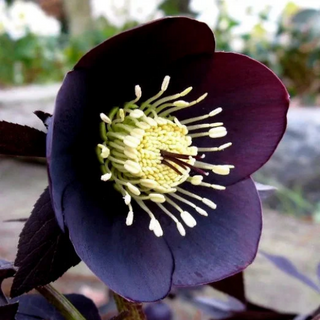KENTUCKY COFFEE TREE
Gymnocladus dioicus
- Unit price
- / per
Description
The Kentucky coffeetree (Gymnocladus dioicus) is a tree native to the Midwest, Upper South, Appalachia, and small pockets of New York in the United States and Ontario in Canada.
The Kentucky coffeetree is a moderately fast-growing tree, and male trees are often grown in parks and along city streets for ornamental purposes. It is considered well-suited to urban environments, as it is tolerant of poor soils, has extreme drought tolerance, and is not vulnerable to serious insect infestations or disease problems. It is cultivated by specialty tree plant nurseries as an ornamental tree for planting in gardens and parks. The peculiarly late-emerging and early-dropping leaves, coupled with the fact that the large leaves mean few twigs in the winter profile, make it a tree that is ideal for urban shading where winter sunlight is to be maximized (such as in proximity to solar hot-air systems).
The Kentucky coffeetree is considered a rare tree species. It is widely distributed, but rare. The tree's native range is limited, occurring from Southern Ontario, Canada and in the United States from Kentucky (where it was first encountered by Europeans) and Connecticut in the east, to Kansas, eastern Nebraska, and southeastern South Dakota in the west, to southern Wisconsin and Michigan in the north, and to northern Louisiana in the south. It is planted as an urban shade tree across the United States and eastern Canada, including California. It has a disjunct population in Central New York.
From 1976 to 1994, the Kentucky coffeetree was the state tree of Kentucky, after which the tulip poplar was returned to that designation.
It is often planted because of its unique appearance and interesting character. There are several Kentucky coffeetrees at Mount Vernon, in the gardens along the path leading up to the house of George Washington.
Trees prefer a rich moist soil, such as bottom lands. Their growth is largely unaffected by heat, cold, drought, insects, disease, road salt, ice, and alkaline soil. Kentucky coffeetree is easy to grow from seed. Filing the seedcoat by hand with a small file, and then soaking the seeds in water for 24 hours will ensure rapid germination.
Note: The unroasted pods and seeds are toxic.
Hardiness zones: 3-8
Seeds per pack: 2 Large seeds
Germination: Kentucky coffee tree is fairly easy to grow from seed. File the seed coating by hand with a small file. Then soak the seeds in water for 24 hours. Place the seeds just under the surface of the soil. Germination should occur in 2-4 weeks. If no germination occurs and the seeds are still firm, they may need to be filed more to allow water to penetrate. Another method is to pour boiling water over them, and then let them soak for 24 hours. We suggest the file method first.
KENTUCKY COFFEE TREE
Gymnocladus dioicus
- Unit price
- / per
Multiple secure payment options available.
Adding product to your cart
You may also like
Description
The Kentucky coffeetree (Gymnocladus dioicus) is a tree native to the Midwest, Upper South, Appalachia, and small pockets of New York in the United States and Ontario in Canada.
The Kentucky coffeetree is a moderately fast-growing tree, and male trees are often grown in parks and along city streets for ornamental purposes. It is considered well-suited to urban environments, as it is tolerant of poor soils, has extreme drought tolerance, and is not vulnerable to serious insect infestations or disease problems. It is cultivated by specialty tree plant nurseries as an ornamental tree for planting in gardens and parks. The peculiarly late-emerging and early-dropping leaves, coupled with the fact that the large leaves mean few twigs in the winter profile, make it a tree that is ideal for urban shading where winter sunlight is to be maximized (such as in proximity to solar hot-air systems).
The Kentucky coffeetree is considered a rare tree species. It is widely distributed, but rare. The tree's native range is limited, occurring from Southern Ontario, Canada and in the United States from Kentucky (where it was first encountered by Europeans) and Connecticut in the east, to Kansas, eastern Nebraska, and southeastern South Dakota in the west, to southern Wisconsin and Michigan in the north, and to northern Louisiana in the south. It is planted as an urban shade tree across the United States and eastern Canada, including California. It has a disjunct population in Central New York.
From 1976 to 1994, the Kentucky coffeetree was the state tree of Kentucky, after which the tulip poplar was returned to that designation.
It is often planted because of its unique appearance and interesting character. There are several Kentucky coffeetrees at Mount Vernon, in the gardens along the path leading up to the house of George Washington.
Trees prefer a rich moist soil, such as bottom lands. Their growth is largely unaffected by heat, cold, drought, insects, disease, road salt, ice, and alkaline soil. Kentucky coffeetree is easy to grow from seed. Filing the seedcoat by hand with a small file, and then soaking the seeds in water for 24 hours will ensure rapid germination.
Note: The unroasted pods and seeds are toxic.
Hardiness zones: 3-8
Seeds per pack: 2 Large seeds
Germination: Kentucky coffee tree is fairly easy to grow from seed. File the seed coating by hand with a small file. Then soak the seeds in water for 24 hours. Place the seeds just under the surface of the soil. Germination should occur in 2-4 weeks. If no germination occurs and the seeds are still firm, they may need to be filed more to allow water to penetrate. Another method is to pour boiling water over them, and then let them soak for 24 hours. We suggest the file method first.
You may also like
You may also like
Recommended Products
CUSTOMERS ARE ALSO BUYING THESE
Testimonials
Here's What Some Of Our Customers Had To Say (Thank you!)

Ferri Seeds is truly a wonderful company. They take the utmost care when delivering your seeds. Mine arrived promptly and when I had any questions, they were so happy to help me. I am looking forward to getting more from them soon. Thank you David for making this a delightful experience.

I got these pretty quickly and in perfect order. I can't wait to see what they look like once I plant them. I have another colour and they were so pretty I had to try these. I have used this seller a few times now with great success, and will again. Everything I have ordered has been of good quality!

I was impressed with Ferriseed’s selection of seeds. Ordering was a breeze and the seeds arrived in a perfect little padded envelope in 9 days. I am very happy and will order from here again. Many thanks.

Never grew coleus from seed, and it was surprisingly easy. They germinated quickly on my heat mat and grow lights. Can't wait to see them in the garden!

We placed our order on Thursday and received it on Monday. Here in Canada the tracking link is accurate. Ferri seeds tells you when they're shipping and when your order is delivered, the seeds arriving in excellent condition. We will definitely be ordering again this spring. Keep up the good work!

Great product ! All seeds germinated and flourished nicely.

My order, made late afternoon, April 27th, and needed in a bit of a rush, was mailed next morning and arrived in my rural mailbox in BC, May 5th.
Thank you for your cheerful, friendly emails and prompt service. I certainly recommend you others and will be sure to keep an eye on the range of seeds you offer in future.

Gt the delivery on time. One week since i potted the seeds. Some of the seeds are already sprouting so i am very happy so far. No complaints yet

Thank you Ferri Seeds for the timely shipments of seeds I ordered. I have been looking to replace that plant for years.

Excellent service, (fastest!!) Great packaging. Also very appreciated is all of the information on how to 'deal' with perennial seeds! Will order again!! Thank you

Ferri Seeds – one of the best online and most helpful businesses I have ever had dealings with. Quick turnaround, dispatch, and beautifully packaged seeds. What more could you want – beautiful flowers would be nice. Well I am sure they will turn out to be.

The seeds came just as described. I appreciate the good follow-up to my questions also.

Fantastically seedlings. They were well packaged. I planted them right away and they’re growing nicely so far.

Fast service, amazing communication!

I happened across Ferri Seeds website when I Googled a particular plant I’d been looking for. I was impressed by their selection of all types of seeds and their good product descriptions along with detailed germination instructions. I found the site and ordered on a Saturday. On Sunday I got a notice that my order had been shipped! The seeds were in my P.O. box on Friday. Such amazing service. It’s too early to comment on germination rates — I’ve just started the stratification process today.

Received in 1-2 weeks in Canada, Ontario. Everything is as ordered. No issues. Ordered through the official web site.

The Japanese anemone seeds arrived promptly. Thank you Ferri Seeds!!

Very fast I am excited

Customer service excellent. Was able to order streptocarpus seeds. Hard to find.

Thank you for having showy Asters., Birdsnest Delphiniums and Colbalt Delphiniums and Obedient plant seeds in Stock. My butterfly garden is almost now complete. And I am cold stratificationing the seeds.

I had a herbarium project with a short deadline. Ferri Seeds were professional, friendly and sent me Alstroemeria seeds promptly. The seeds arrived in a protective sleeve within a letter envelope. The herbarium is complete! I highly recommend Ferri Seeds! Thank you!

Very good seller!

Very satisfied, quick service

It's been a pleasure dealing with Ferri Seeds!

Amazing selection. Fast service. I look forward to ordering in the future.
We carry a diverse selection seeds from around the world, many are rare and hard to find!
Regular new seed stock, special cold/dry storage facility, and record keeping ensures our stock is fresh and ready to grow for you.
When you sign up, you are agreeing to receive promotional emails and other marketing communications from us. In the future, you can always unsubscribe.





